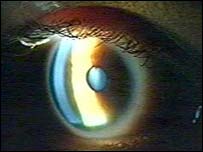Blind people will be able to recognize faces using the device

American scientists have designed a bionic eye that will allow the blind to see again. The eye contains a computer chip that sits on the back of the eye and is linked to a tiny video camera built into the glasses. The images taken by the camera are transmitted to the chip, which translates them into pulses that the brain can interpret.
The device was designed by Prof. Gilsin Danieli at Johns Hopkins University in Baltimore.
Prof Daniely revealed the details at the National Institute for the Blind conference in London on Monday. According to him, clinical trials in humans will begin during the year.
Although images produced by an artificial eye are far from perfect, they will be clear enough to allow someone who would otherwise be completely blind to recognize a face. said. The breakthrough is expected to help patients with the main cause of blindness: macular degeneration, which affects half a million Britons. This occurs when there is damage to the spot (macular) located in the central part of the retina, the place where light is focused and converted into nerve signals in the center of the brain. The graft bypasses the diseased cells in the retina and encourages the remaining healthy cells.
to see the light
According to Prof. Danieli: We implant into the cornea an implant that includes tiny electrodes. If a single electrode is stimulated, the person can see a single point of light. They have done experiments containing several electrodes and the final device will contain 50-100 electrodes and give a blind person a better overall picture. "We hope that this will be enough for the person to be able to walk inside a building, find the door or window and avoid obstacles."
"For us, the image obtained using the device seems very basic, but for someone who was previously blind, this is a big step forward," he said, adding: "There is still a lot of work to be done to refine the device and a version that will allow the blind to see faces is still down the road."
According to him, training the blind to learn how to interpret the blurry images may help.
"This is a revolutionary technology and it really has the potential to change people's lives." Says Annette Lifestone from the British National Institute for the Blind, "but we still need to be aware that the technology will only mature in the future, and the device cannot be obtained today."
